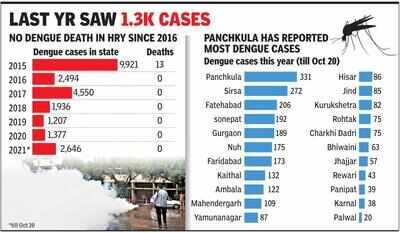- News
- City News
- gurgaon News
- Stinging in the rain: At 2.6k, Hry’s dengue tally at 3-yr high
Stinging in the rain: At 2.6k, Hry’s dengue tally at 3-yr high
Stinging in the rain: At 2.6k, Hry’s dengue tally at 3-yr high

Gurgaon: Haryana’s official dengue case count is at a three-year high, owing to a long monsoon. With the rains continuing late into the year, health officials have warned that the number of cases is likely to increase.
As of Wednesday, the state’s tally stood at 2,646, already significantly higher than the total 1,936 cases reported in 2018. In 2019 and 2020, the caseload was 1,207 and 1,377. So far, Haryana has not reported any dengue deaths this season.
Districts with the highest number of cases have been marked “most affected”. These include Panchkula (331), followed by Sirsa (272), Fatehabad (206), Sonipat (192), Gurgaon (189), Nuh (175) and Faridabad (173). The lowest number of cases have been reported from Palwal (20), Karnal (38), Panipat (39), Rewari (43) and Jhajjar (57). Of the total 2,646 cases, 1,643 were reported by government hospitals and 1,003 by private facilities.
Rajeev Arora, ACS (health), Haryana, said, “With an aim to prevent mortality due to dengue, a provision of free single donor platelets (SDP) has been made for patients in government hospitals across the state. Earlier, the hospitals charged Rs 8,500 per unit of SDP.”
According to the health department, about 420 domestic breeding checkers have been deployed in all districts while 1,410 hand-operated and 35 vehicle-mounted fogging machines have been pressed into service. Indoor residual sprays are also being carried out in 57 high-risk areas where malaria incidence was high in the past three years.
Moreover, about 8,023 water bodies have been identified for release of Gambusia fish (mosquito killer fish). The fish have already been released in 7,167 water bodies and will be released into the rest as well. About 112 fish hatcheries are functional in the state at present.
Meanwhile, Dr Virender Yadav, chief medical officer, Gurgaon, said rapid response teams were carrying out door-to-door screening in dengue clusters. “We appeal to people to ensure that water doesn’t remain stagnant in and around their locality,” he added.
The city reported its first cases of the season on August 24, when five people tested positive. It had seen the highest number of cases in 2015, at 451. The figure stood at 86 in 2016, 66 in 2017 and 93 in 2018. While 22 cases were reported in 2019, 51 cases were recorded in 2020.
As of Wednesday, the state’s tally stood at 2,646, already significantly higher than the total 1,936 cases reported in 2018. In 2019 and 2020, the caseload was 1,207 and 1,377. So far, Haryana has not reported any dengue deaths this season.
Districts with the highest number of cases have been marked “most affected”. These include Panchkula (331), followed by Sirsa (272), Fatehabad (206), Sonipat (192), Gurgaon (189), Nuh (175) and Faridabad (173). The lowest number of cases have been reported from Palwal (20), Karnal (38), Panipat (39), Rewari (43) and Jhajjar (57). Of the total 2,646 cases, 1,643 were reported by government hospitals and 1,003 by private facilities.
Rajeev Arora, ACS (health), Haryana, said, “With an aim to prevent mortality due to dengue, a provision of free single donor platelets (SDP) has been made for patients in government hospitals across the state. Earlier, the hospitals charged Rs 8,500 per unit of SDP.”
Aedes Agypti, the dengue-causing mosquito, typically breeds in stagnant water in containers such as desert coolers, overhead tanks, plastic bags, bottles, cups thrown on garbage, discarded items on rooftops, flowerpots and bird baths. During the rainy season, it is important to identify and eliminate mosquito-breeding sites by emptying water from containers.
According to the health department, about 420 domestic breeding checkers have been deployed in all districts while 1,410 hand-operated and 35 vehicle-mounted fogging machines have been pressed into service. Indoor residual sprays are also being carried out in 57 high-risk areas where malaria incidence was high in the past three years.
Moreover, about 8,023 water bodies have been identified for release of Gambusia fish (mosquito killer fish). The fish have already been released in 7,167 water bodies and will be released into the rest as well. About 112 fish hatcheries are functional in the state at present.
Meanwhile, Dr Virender Yadav, chief medical officer, Gurgaon, said rapid response teams were carrying out door-to-door screening in dengue clusters. “We appeal to people to ensure that water doesn’t remain stagnant in and around their locality,” he added.
The city reported its first cases of the season on August 24, when five people tested positive. It had seen the highest number of cases in 2015, at 451. The figure stood at 86 in 2016, 66 in 2017 and 93 in 2018. While 22 cases were reported in 2019, 51 cases were recorded in 2020.
FacebookTwitterLinkedinEMail
Start a Conversation
end of article
Quick Links
Delhi Air PollutionDelhi TemperatureChennai WeatherBangalore TemperatureCovid vaccination centres in DelhiCoronavirus in DelhiRTPCR test in GurgaonHyderabad RainPollution level in BangaloreDelhi SmogDelhi TemperatureNoida AQIGurgaon AQI todayFire in MumbaiMumbai RainsCovid 19 RT PCR Test in NoidaDelhi AQI todaySrinagar encounter

